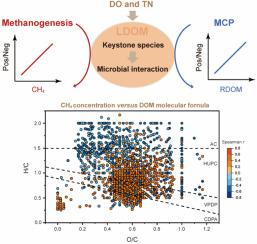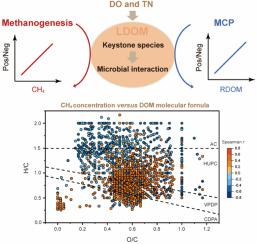基石类群推动内陆水域甲烷和难溶解有机物的同步产生
IF 11.4
1区 环境科学与生态学
Q1 ENGINEERING, ENVIRONMENTAL
引用次数: 0
摘要
甲烷(CH4)和难降解有机物(RDOM)的产生都依赖于内陆水域的微生物群落,而这两个过程之间的联系及其背后的微生物调控机制尚不清楚。因此,我们对中国内陆水域进行了大规模调查,主要通过色谱、光学、质谱和高通量测序分析,测定了CH4浓度、DOM化学组成、微生物群落组成和相关环境参数,以澄清上述问题。在这里,我们发现内陆水域的微生物群落会同步产生 CH4 和 RDOM。在关键类群(主要是 Fluviicola 和 Polynucleobacter)的驱动下,微生物的合作不断加强,这可能会促进可溶性 DOM 向 RDOM 的转化,同时有利于产甲烷微生物群落产生 CH4。因此,CH4 和 RDOM 显示出一致的空间差异,主要受总氮和溶解氧浓度的影响。这一发现加深了人们对微生物驱动的碳转化的理解,有助于更准确地评估内陆水域的碳源-汇关系。本文章由计算机程序翻译,如有差异,请以英文原文为准。


Keystone taxa drive the synchronous production of methane and refractory dissolved organic matter in inland waters
The production of both methane (CH4) and refractory dissolved organic matter (RDOM) depends on microbial consortia in inland waters, and it is unclear yet the link of these two processes and the underlying microbial regulation mechanisms. Therefore, a large-scale survey was conducted in China's inland waters, with the measurement of CH4 concentrations, DOM chemical composition, microbial community composition, and relative environmental parameters mainly by chromatographic, optical, mass spectrometric, and high-throughput sequencing analyses, to clarify the abovementioned questions. Here, we found a synchronous production of CH4 and RDOM linked by microbial consortia in inland waters. The increasing microbial cooperation driven by the keystone taxa (mainly Fluviicola and Polynucleobacter) could promote the transformation of labile DOM into RDOM and meanwhile benefit methanogenic microbial communities to produce CH4. As such, CH4 and RDOM showed consistent spatial differences, which were mainly influenced by total nitrogen and dissolved oxygen concentrations. This finding deepened the understanding of microbial-driven carbon transformation and will help to more accurately evaluate the carbon source-sink relationship in inland waters.
求助全文
通过发布文献求助,成功后即可免费获取论文全文。
去求助
来源期刊

Water Research
环境科学-工程:环境
CiteScore
20.80
自引率
9.40%
发文量
1307
审稿时长
38 days
期刊介绍:
Water Research, along with its open access companion journal Water Research X, serves as a platform for publishing original research papers covering various aspects of the science and technology related to the anthropogenic water cycle, water quality, and its management worldwide. The audience targeted by the journal comprises biologists, chemical engineers, chemists, civil engineers, environmental engineers, limnologists, and microbiologists. The scope of the journal include:
•Treatment processes for water and wastewaters (municipal, agricultural, industrial, and on-site treatment), including resource recovery and residuals management;
•Urban hydrology including sewer systems, stormwater management, and green infrastructure;
•Drinking water treatment and distribution;
•Potable and non-potable water reuse;
•Sanitation, public health, and risk assessment;
•Anaerobic digestion, solid and hazardous waste management, including source characterization and the effects and control of leachates and gaseous emissions;
•Contaminants (chemical, microbial, anthropogenic particles such as nanoparticles or microplastics) and related water quality sensing, monitoring, fate, and assessment;
•Anthropogenic impacts on inland, tidal, coastal and urban waters, focusing on surface and ground waters, and point and non-point sources of pollution;
•Environmental restoration, linked to surface water, groundwater and groundwater remediation;
•Analysis of the interfaces between sediments and water, and between water and atmosphere, focusing specifically on anthropogenic impacts;
•Mathematical modelling, systems analysis, machine learning, and beneficial use of big data related to the anthropogenic water cycle;
•Socio-economic, policy, and regulations studies.
 求助内容:
求助内容: 应助结果提醒方式:
应助结果提醒方式:


